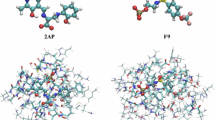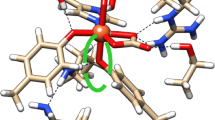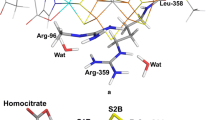Abstract
The effect of axial ligand nodal plane orientation on the contact and pseudocontact shifts of a symmetrical low-spin octamethylferriheme center has been calculated as a function of the angle of the axial ligand. Simple Hückel techniques have been used to estimate the contact contribution, and values obtained from model hemes, together with counter-rotation of the g-tensor, have been used to estimate the pseudocontact contribution, for the eight β-pyrrole methyl and four meso-H positions. It is found that the maximum and minimum contact shifts occur when the axial ligand is aligned at an angle of ±15° to the meso-H axes of the heme, rather than when the axial ligand plane lies along the porphyrin nitrogens, as assumed previously by some investigators. For systems having one planar axial ligand or two ligands in parallel planes, the contact and pseudocontact contributions at the meso-H positions are comparable in size (at least on the basis of simple Hückel estimates), while the contact contribution clearly dominates the isotropic shifts of the heme methyls. Allowing for the substituent effect of the 2,4-vinyls of protohemin, or the 2,4-thioethers of hemin c, as well as the average diamagnetic shifts of the heme methyls and meso-H, plots of the predicted shifts as a function of axial ligand nodal plane orientation have been constructed for hemin b- and c-containing proteins. Excellent agreement in the order of shifts, and reasonable agreement in the sizes of the observed shifts, is observed in the majority of the ferriheme proteins for which the methyl and meso-H resonances have been assigned and proton shifts reported. Plots have also been constructed for hemin c-containing proteins having the two axial ligand nodal planes oriented at relative angles of 40°, 70°, and 80°. Excellent agreement in the order of shifts, and reasonable agreement in the magnitudes of the observed shifts, is observed in all cases of bacterial cytochromes which do not fit the plots that assume the ligands are in parallel planes, except one – the cytochrome c-552 of Nitrosomonas europae. Except for this case, where the order of the predicted methyl shifts at any angle of the axial ligands disagrees with the observed, the reasons can usually be attributed to a large dihedral angle between two axial ligand nodal planes, to strong H-bonding interactions involving His and/or CN– ligands, or to off-axis binding of one (or both) axial ligand(s). Ruffling of the porphyrin ring may also contribute to the contact shift in as yet undefined ways. Hence, despite the simplicity of the calculations, the agreement with observed data is highly satisfying and the concept of the importance of axial ligand plane orientation on the observed proton shifts of heme proteins is fully confirmed.
Similar content being viewed by others
Author information
Authors and Affiliations
Additional information
Received: 15 June 1998 / Accepted: 6 August 1998
Rights and permissions
About this article
Cite this article
Shokhirev, N., Walker, F. The effect of axial ligand plane orientation on the contact and pseudocontact shifts of low-spin ferriheme proteins. JBIC 3, 581–594 (1998). https://doi.org/10.1007/s007750050271
Issue Date:
DOI: https://doi.org/10.1007/s007750050271




